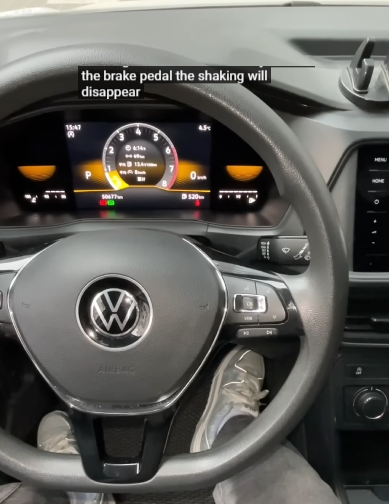
Few things are more unsettling for drivers than feeling the steering wheel vibrate or shake when applying the brakes. It is not only uncomfortable but also a warning sign that something in your car’s braking or suspension system may need attention. Ignoring the issue can lead to unsafe driving conditions, increased wear on your vehicle, and costly repairs later.
In this article, we’ll explore the causes of steering wheel shaking when braking, how to diagnose the problem, and the practical steps you can take to solve it.
Why Does the Steering Wheel Shake When Braking?
Steering wheel vibration during braking typically indicates that the braking system or related components are not functioning smoothly. Here are the most common causes:
1. Warped Brake Rotors
Brake rotors are metal discs that the brake pads clamp down on to slow the vehicle. Over time, excessive heat from braking, poor-quality rotors, or improper installation can cause the rotors to warp. When this happens, the surface becomes uneven, and the brake pads cannot maintain consistent contact, leading to vibrations that travel through the steering wheel.
2. Worn or Uneven Brake Pads
If brake pads are worn down unevenly or installed incorrectly, they may create inconsistent pressure on the rotors. This uneven contact causes pulsations and shaking during braking. Low-quality pads can also leave uneven deposits on the rotors, which mimic the symptoms of warped rotors.
3. Suspension and Steering Issues
Sometimes, the problem is not directly related to the brakes but to the suspension and steering components. Worn ball joints, tie rods, or control arm bushings can cause looseness in the steering system. When you apply the brakes, this looseness translates into vibrations at the steering wheel.
4. Wheel Alignment Problems
Improper wheel alignment or unbalanced tires can lead to vibrations when driving at higher speeds. Braking adds stress to the already misaligned wheels, intensifying the steering wheel shake.
5. Stuck Calipers
Brake calipers apply pressure on the pads to stop the car. If a caliper sticks, it can cause one wheel to brake harder than the others, leading to vibrations, uneven braking, and sometimes even pulling to one side.
6. Wheel Bearing Wear
Wheel bearings support the rotation of the wheels. If they become worn or loose, vibrations may be felt when braking, especially through the steering wheel.

How to Diagnose the Problem
Before attempting a fix, proper diagnosis is essential. Here’s how you can identify the root cause:
- Check for vibrations at different speeds.
If the steering wheel shakes primarily at high speeds when braking, warped rotors are a likely culprit. - Inspect the brake pads and rotors.
Look for uneven wear on pads, grooves, or discoloration on rotors, which indicates overheating. - Listen for noises.
Squealing, grinding, or clunking noises can help identify worn pads, suspension issues, or bearing problems. - Test braking on different road surfaces.
If shaking only happens under heavy braking, the rotors are probably to blame. If it occurs even with light braking, suspension components may be worn out. - Check for pulling to one side.
If your car pulls when braking, you may have a stuck caliper or uneven brake pressure.
Solutions to Steering Wheel Shaking
Once the problem is identified, you can move on to fixing it. Here are the most effective solutions:
1. Replace or Resurface Warped Brake Rotors
If your rotors are warped, you have two options:
- Resurfacing (machining): This involves shaving a thin layer off the rotor to make the surface even again. It’s a cheaper solution but only works if the rotors still have enough thickness left.
- Replacement: If the rotors are too thin, cracked, or badly damaged, replacement is the only safe option. Always replace rotors in pairs (front or rear) to maintain balanced braking.
2. Install New Brake Pads
Brake pads should be replaced if they are worn, uneven, or of poor quality. When replacing pads:
- Choose high-quality pads designed for your car.
- Always replace both front or both rear pads together.
- Properly bed-in the pads after installation to prevent uneven deposits.
3. Inspect and Repair Suspension Components
If suspension parts such as tie rods, ball joints, or bushings are worn out, they need to be replaced. This ensures the steering system remains tight and responsive, reducing vibrations when braking.
4. Correct Wheel Alignment and Balance
If the problem is caused by alignment issues, a professional wheel alignment service will restore the correct angles. Tire balancing should also be done regularly to prevent uneven wear and vibrations.
5. Repair or Replace Stuck Calipers
A sticking caliper can often be fixed by cleaning and lubricating it. If it is too damaged, replacement is the best option. This not only solves steering wheel vibration but also ensures even braking force across all wheels.
6. Replace Worn Wheel Bearings
If diagnosis points to bad wheel bearings, they should be replaced immediately. Driving with worn bearings is unsafe and can lead to further damage to the wheel hub assembly.

Preventing Steering Wheel Shaking in the Future
Solving the problem is important, but prevention will save you time and money in the long run. Here are some tips:
- Brake Smoothly – Avoid slamming on the brakes unnecessarily. This prevents excessive heat buildup in rotors and pads.
- Use Quality Parts – Always invest in reputable brands for rotors, pads, and suspension components. Cheap parts wear out faster and cause more issues.
- Service Your Brakes Regularly – Regular inspections help catch problems early, before vibrations become noticeable.
- Rotate and Balance Tires – Regular tire maintenance reduces uneven wear and improves overall stability.
- Avoid Overloading Your Car – Carrying heavy loads strains the braking system and suspension.
- Cool Down Brakes After Heavy Use – If you’ve been driving downhill or braking hard, give your brakes time to cool to prevent warping.
When to Seek Professional Help
While some tasks like checking brake pads or tire condition can be done at home, others require professional expertise and tools. You should take your car to a certified mechanic if:
- The shaking is severe and happens at all speeds.
- You notice pulling to one side when braking.
- There are loud grinding or clunking noises.
- Brake warning lights appear on your dashboard.
Professional mechanics can perform detailed inspections, such as measuring rotor thickness, checking caliper function, and ensuring all suspension components are tight and safe.

Conclusion
Steering wheel shaking when braking is not something to ignore. It signals issues ranging from warped rotors and worn brake pads to suspension and alignment problems. The good news is that with proper diagnosis and timely repairs—such as replacing rotors, installing quality pads, checking suspension parts, and ensuring proper alignment—you can eliminate the shaking and restore smooth, safe braking.
Remember, your car’s braking system is its most important safety feature. Addressing steering wheel vibrations early ensures not only comfort but also safety for you, your passengers, and everyone else on the road.



